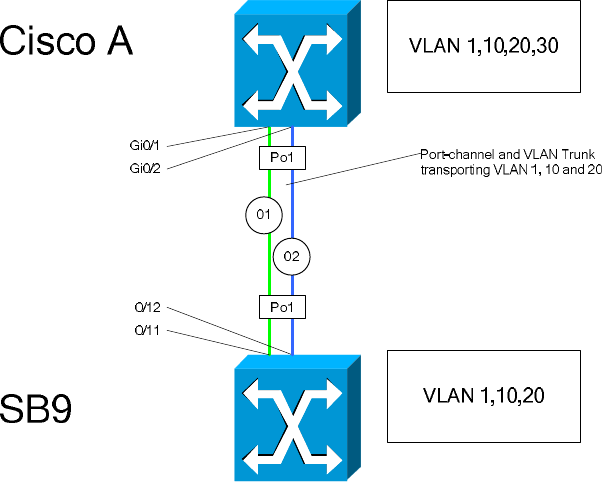
White Paper Issue: October 2006 Integration of BX600 SB9 Switches in Cisco Networks Page 8 / 47
2.3 VLANs and Trunks
2.3.1 Introduction
Most network administrators want to partition their network into multiple broadcast domains to provide better network stability
and better information security. This is implemented using virtual LAN technology (VLANs) which provides multiple virtual LAN
segments in one switched network domain as specified in the standard 802.1Q.
A number of protocols have been developed to simplify the management of such VLANs. While Cisco uses its own proprietary
VLAN Trunking Protocol (VTP), the IEEE describes the GARP VLAN Registration Protocol (GVRP) which has been
implemented in the SB9.
Figure 2 : VLAN Trunk between SB9 and Cisco Switch
When multiple switches are interconnected there is often a need to transport multiple VLANs over one line. This technique is
called VLAN Trunking and is described in the IEEE standard 802.1Q and implemented in the SB9. Some older Cisco switches
implement a proprietary and incompatible ISL, but all devices found in modern datacenters will support 802.1Q trunks. Figure 2
shows a typical setup between a Cisco and an SB9 switch, whereby a port-channel is combined with a VLAN trunk.
It is important to know the role of the so-called native VLAN on an 802.1Q trunk. All the packets on the trunk are encapsulated
in 802.1Q packets, which means that a header containing the VLAN number and certain other information is added to the
packet before it is transported over the trunk. Only the packets of the native VLAN are untagged for a variety of reasons. In most
installations, VLAN1 is configured as native VLAN which is used for a number of protocols, such as VTP, CDP, STP, etc.
2.3.2 Recommended Solution
Cisco’s VTP and standard GVRP are not compatible. Since a VLAN registration protocol is useful only when applied to several
switches within a switch domain, GVRP is not recommended in a Cisco environment.
A number of features of the current version V 2.0 make it neither usual nor advisable to use VTP in datacenter networks:
• The design of the VTP server and client concept is extremely delicate: if you bring in a VTP client switch with a higher
configuration version number than the rest of the network, all the switches will copy the VLAN database from this
switch. This will be a disaster if the new switch has been used in a laboratory and one or more VLANs had been
deleted in the meantime.
• Manual trunk configuration is very deterministic as to which VLAN is on which trunk. This will simplify troubleshooting.
• Manual trunk configuration may help the administrator to set up a simple load sharing.
We therefore recommend using manual VLAN registration in a Cisco datacenter network.
Since the SB9 does not support ISL, the only solution for VLAN trunks to Cisco switches is IEEE 802.1Q. When STP is used,
which is the case for most of datacenters, it is necessary to use a native VLAN because the standard defines that BPDUs have
to be transported untagged. (See also Spanning Tree)
Cisco recommends not using VLAN 1 for anything productive. It therefore makes sense to configure the management IP
address of the SB9 into another VLAN, but it is nevertheless important to have one native VLAN defined on the trunk.
2.3.3 Configuration
You set up a VLAN trunk as shown in Figure 2 and our recommendations by performing the following steps:
• Step 1: Configure the port-channels
• Step 2: Define the VLANs
• Step 3: Configure VLAN trunk
• Step 4: Verify the VLAN trunk


















